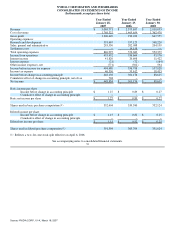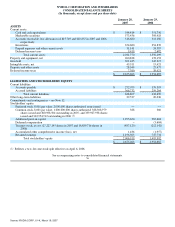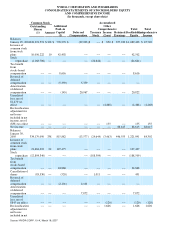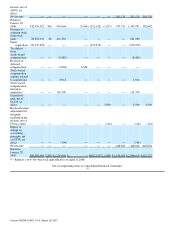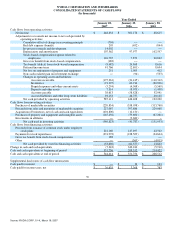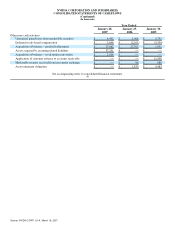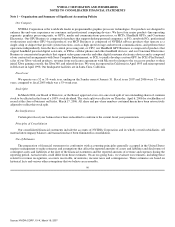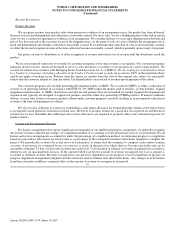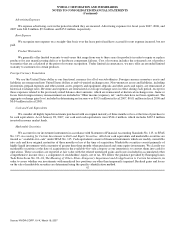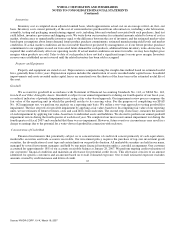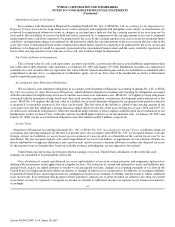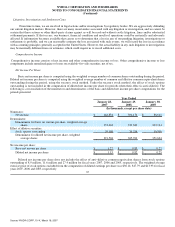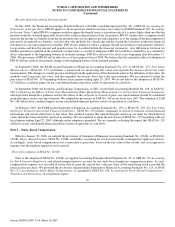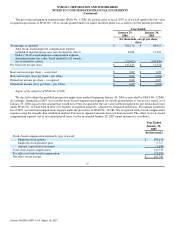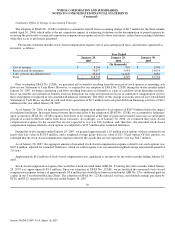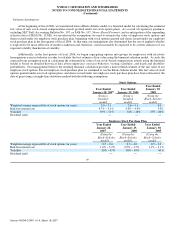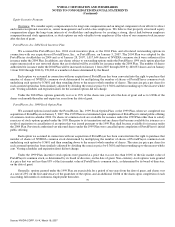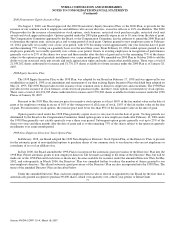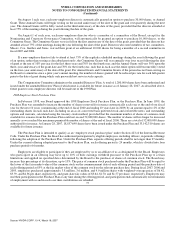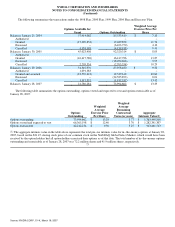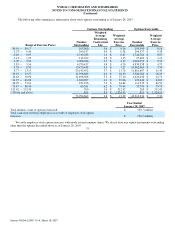NVIDIA 2007 Annual Report Download - page 73
Download and view the complete annual report
Please find page 73 of the 2007 NVIDIA annual report below. You can navigate through the pages in the report by either clicking on the pages listed below, or by using the keyword search tool below to find specific information within the annual report.
NVIDIA CORPORATION AND SUBSIDIARIES
NOTES TO CONSOLIDATED FINANCIAL STATEMENTS
(Continued)
Impairment of Long−Lived Assets
In accordance with Statement of Financial Accounting Standards No. 144, or SFAS No. 144, Accounting for the Impairment or
Disposal of Long−Lived Assets, long−lived assets, such as property and equipment and intangible assets subject to amortization, are
reviewed for impairment whenever events or changes in circumstances indicate that the carrying amount of an asset may not be
recoverable. Recoverability of assets to be held and used is measured by a comparison of the carrying amount of an asset to estimated
undiscounted future cash flows expected to be generated by the asset. If the carrying amount of an asset exceeds its estimated future
cash flows, an impairment charge is recognized for the amount by which the carrying amount of the asset exceeds the fair value of the
asset. Fair value is determined based on the estimated discounted future cash flows expected to be generated by the asset. Assets and
liabilities to be disposed of would be separately presented in the consolidated balance sheet and the assets would be reported at the
lower of the carrying amount or fair value less costs to sell, and would no longer be depreciated.
Fair Value of Financial Instruments
The carrying value of cash, cash equivalents, accounts receivable, accounts payable and accrued liabilities approximate their
fair values due to their relatively short maturities as of January 28, 2007 and January 29, 2006. Marketable securities are comprised of
available−for−sale securities that are reported at fair value with the related unrealized gains and losses included in accumulated other
comprehensive income (loss), a component of stockholders' equity, net of tax. Fair value of the marketable securities is determined
based on quoted market prices.
Accounting for Asset Retirement Obligations
We account for asset retirement obligations in accordance with Statement of Financial Accounting Standards No. 143, or SFAS
No. 143, Accounting for Asset Retirement Obligations, which addresses financial accounting and reporting for obligations associated
with the retirement of tangible long−lived assets and the associated asset retirement costs. SFAS No. 143 applies to legal obligations
associated with the retirement of long−lived assets that result from the acquisition, construction, development and/or normal use of the
assets. SFAS No. 143 requires that the fair value of a liability for an asset retirement obligation be recognized in the period in which it
is incurred if a reasonable estimate of fair value can be made. The fair value of the liability is added to the carrying amount of the
associated asset and this additional carrying amount is depreciated over the life of the asset. During fiscal years 2006 and 2007, we
recorded asset retirement obligations to return the leasehold improvements to their original condition upon lease termination at our
headquarters facility in Santa Clara, California and our leasehold improvements at our international sites. At January 28, 2007 and
January 29, 2006, our net asset retirement obligations were $6.4 million and $6.5 million, respectively.
Income Taxes
Statement of Financial Accounting Standards No. 109, or SFAS No. 109, Accounting for Income Taxes, establishes financial
accounting and reporting standards for the effect of income taxes. In accordance with SFAS No. 109, we recognize federal, state and
foreign current tax liabilities or assets based on our estimate of taxes payable or refundable in the current fiscal year by tax
jurisdiction. We also recognize federal, state and foreign deferred tax assets or liabilities, as appropriate, for our estimate of future tax
effects attributable to temporary differences and carryforwards; and we record a valuation allowance to reduce any deferred tax assets
by the amount of any tax benefits that, based on available evidence and judgment, are not expected to be realized.
United States income tax has not been provided on earnings of our non−United States subsidiaries to the extent that such
earnings are considered to be permanently reinvested.
Our calculation of current and deferred tax assets and liabilities is based on certain estimates and judgments and involves
dealing with uncertainties in the application of complex tax laws. Our estimates of current and deferred tax assets and liabilities may
change based, in part, on added certainty or finality to an anticipated outcome, changes in accounting standards or tax laws in the
United States or foreign jurisdictions where we operate, or changes in other facts or circumstances. In addition, we recognize liabilities
for potential United States and foreign income tax contingencies based on our estimate of whether, and the extent to which, additional
taxes may be due. If we determine that payment of these amounts is unnecessary or if the recorded tax liability is less than our current
assessment, we may be required to recognize an income tax benefit or additional income tax expense in our financial statements,
accordingly. 64
Source: NVIDIA CORP, 10−K, March 16, 2007


